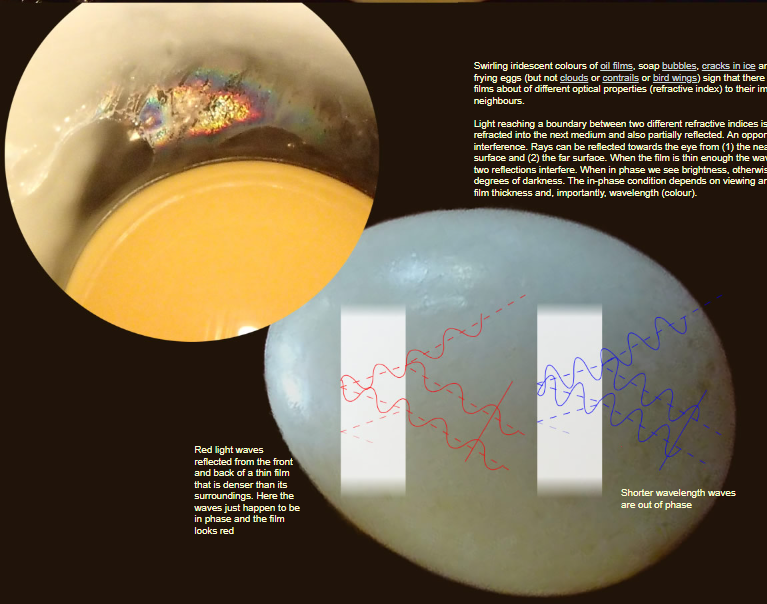Frying Pan Optics - OPOD
Frying Pan Optics - Unveiling the Colorful World of Thin Films
Have you ever noticed a mesmerizing play of colors on the surface of a frying egg or in a soap bubble? These vibrant hues, reminiscent of rainbows, are not limited to natural phenomena like clouds or bird wings. In fact, they can be observed in various everyday objects, such as oil films, soap bubbles, cracks in ice, and even frying eggs. This captivating optical phenomenon, known as "frying pan optics," occurs due to the presence of thin films with different refractive indices. Let's dive into the science behind this fascinating display of iridescence.
When light encounters a boundary between two substances with different refractive indices, it undergoes partial refraction and reflection. This interaction creates an opportunity for interference, leading to the formation of vibrant colors. In the case of frying pan optics, the thin film responsible for the iridescence can be found between the melted butter and the egg white in the pan. It is also possible that protein layers within the egg white contribute to the phenomenon.
The interplay of light waves reflected from the front and back surfaces of the thin film determines the colors we observe. When the film is thin enough, the waves from these two reflections can interfere with each other. If they are in phase, we perceive brightness, while out-of-phase waves result in varying degrees of darkness. Importantly, the in-phase condition depends on factors such as the viewing angle, film thickness, and wavelength of light.
Interestingly, the colors we see in frying pan optics are influenced by the wavelength of light. Different wavelengths correspond to different colors in the visible spectrum. For instance, red light waves reflected from both the front and back surfaces of a thin film that is denser than its surroundings may be perfectly in phase, resulting in a vibrant red color. However, shorter wavelength waves, such as blue or violet, may be out of phase, leading to a different appearance.
To better understand this phenomenon, let's take a closer look at some key points:
- Frying pan optics can be observed in various thin films with different optical properties, such as oil films, soap bubbles, cracks in ice, and frying eggs.
- The interplay of partially refracted and reflected light waves in thin films creates an opportunity for interference.
- The interference of waves from the front and back surfaces of the film determines the observed colors.
- In-phase waves result in brightness, while out-of-phase waves lead to degrees of darkness.
- The thickness of the film, viewing angle, and wavelength of light influence the in-phase condition.
- The colors we perceive in frying pan optics are dependent on the wavelength of light.
By unraveling the science behind frying pan optics, we gain a deeper appreciation for the colorful world of thin films. Whether it's the shimmering surface of an oil film or the ethereal beauty of a soap bubble, these everyday occurrences reveal the intricate nature of light and its interactions with different materials. So, the next time you're cooking breakfast or blowing bubbles, take a moment to marvel at the captivating display of frying pan optics that surrounds you.
Frying Pan Optics

Samantha Lawler (Sundog Vegetables) caught this fleeting iridescence.
"I was frying an egg from one of my ducks for breakfast, and noticed a lovely little rainbow, almost like the iridescence you see in a soap bubble or oil slick. I only managed one decent picture before the bottom layer of the egg cooked and the white turned opaque, which happened within seconds. I would guess that the iridescence is either from the interface between the white and the melted butter in the pan, or possibly from protein layers within the white itself? We joked that our organic free-range ducks are so happy that they now include rainbows in their eggs."
©Samantha Lawler, shown with permission

Swirling iridescent colours of oil films, soap bubbles, cracks in ice and even frying eggs (but not clouds or contrails or bird wings) sign that there are thin films about of different optical properties (refractive index) to their immediate neighbours.
Light reaching a boundary between two different refractive indices is partially refracted into the next medium and also partially reflected. An opportunity for interference. Rays can be reflected towards the eye from (1) the nearest film surface and (2) the far surface. When the film is thin enough the waves of the two reflections interfere. When in phase we see brightness, otherwise degrees of darkness. The in-phase condition depends on viewing angle and film thickness and, importantly, wavelength (colour).
Red light waves reflected from the front and back of a thin film that is denser than its surroundings. Here the waves just happen to be in phase and the film looks red
Shorter wavelength waves are out of phase
Note: this article has been automatically converted from the old site and may not appear as intended. You can find the original article here.
Reference Atmospheric Optics
If you use any of the definitions, information, or data presented on Atmospheric Optics, please copy the link or reference below to properly credit us as the reference source. Thank you!
-
<a href="https://atoptics.co.uk/blog/frying-pan-optics-opod/">Frying Pan Optics - OPOD</a>
-
"Frying Pan Optics - OPOD". Atmospheric Optics. Accessed on November 26, 2024. https://atoptics.co.uk/blog/frying-pan-optics-opod/.
-
"Frying Pan Optics - OPOD". Atmospheric Optics, https://atoptics.co.uk/blog/frying-pan-optics-opod/. Accessed 26 November, 2024
-
Frying Pan Optics - OPOD. Atmospheric Optics. Retrieved from https://atoptics.co.uk/blog/frying-pan-optics-opod/.